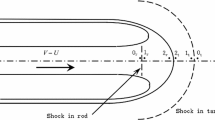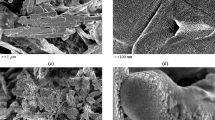Abstract
Interaction of impact shock waves that could detonate an explosive (Composition B) confined in a thin-walled container impacted by a cylindrical projectile is numerically studied, based on the Forest Fire explosive reaction rate model. After the impact, rarefaction waves from projectile periphery and front cover–explosive interface catch up the forward-moving shock fronts in the explosive as well as in the projectile. At a high impact velocity, the transmitted shock front induces detonation at the front cover–explosive interface. At an intermediate velocity, the rate of energy release from the shock-compressed volume in the explosive is such that the associated effects prevail over the effects caused by rarefaction waves, leading to detonation after the shock wave travels a certain distance in the explosive. There is a range of minimum impact velocities at which the effect of rarefaction waves prevails over the energy release; hence, the detonation is excited not behind the shock-wave front moving over the explosive but only after shock-wave reflection from the high-impedance back plate. It is suggested that, in interpreting the detonation behavior of an explosive confined by a high-impedance container, one should take into account the effects of shock-wave interaction with container walls.
Similar content being viewed by others
REFERENCES
“Naval surface warfare center. Hazard assessment tests for non-nuclear munitions,” Military Standard No. MILSTD-2105B, Dept. of Defense, Indian Head (1994).
M. Held, “Initiation of covered high explosives has many facettes,” in: Proc. Third European Armoured Fighting Vehicle Symp., Shrivenham, UK (1998).
U.S. Army Test and Evaluation Command. Typical Reactive Armor Safety Tests. Test Operations Procedure No. TOP-2-2-623. Aberdeen Proving Ground (1993).
K. L. Bahl, H. C. Vantine, and R. C. Weingart, “The shock initiation of bare and covered explosives by projectile impact,” in: Proc. Seventh Symp. (Int.) on Detonation, Office of Naval Research, Arlington (1981), pp. 325–335.
D. Eldh, B. Persson, B. Ohlin, et al., “Shooting test with plane impact surface for determining the sensitivity of explosives,” Explosivstoffe, 5, 97–103 (1963).
N. Griffiths, R. M. Laidler, and S. T. Spooner, “Some aspects of the shock initiation of condensed explosives,” Combust. Flame, 7, 347–352 (1963).
H. R. James, P. J. Haskins, and M. D. Cook, “Prompt shock initiation of cased explosives by projectile impact,” Propellants, Explos., Pyrotech., 21, 251–257 (1996).
W. Lawrence and J. Starkenberg, “The effects of the failure diameter of an explosive on its response to shaped charge jet attack,” Army Research Laboratory Report No. ARL-TR-1350, Aberdeen Proving Ground (1997).
R. A. J. Borg and D. A. Jones, “Numerical simulation of projectile impact experiments using the Forest Fire reaction rate model,” Defence Science and Technology Organization Report No. DSTO-TR-0325, Canberra, Australia (1996).
P. C. Chou, D. Liang, and W. J. Flis, “Shock and shear initiation of explosive,” Shock Waves, 1, 285–292 (1991).
M. Held, “Reaction thresholds in unconfined and confined charges by shock load,” Propellants, Explos., Pyrotech., 25, 107–111 (2000).
H. R. James, P. J. Haskins, and M. D. Cook, “Effect of case thickness and projectile geometry on the shock initiation threshold for a given explosive,” in: AGARD Conference Proc., Vol. 511 (1992), pp. 18/1–18/15.
M. D. Cook, P. J. Haskins, and H. R. James, “Projectile impact initiation of explosive charges,” in: Proc. Ninth Symp. (Int.) on Detonation, Office of Naval Research, Arlington (1989), pp. 1441–1450.
M. Held, “Test set-up for instrumented initiation tests,” Propellants, Explos., Pyrotech., 25, 49–53 (2000).
T. S. Sumrall, “Large-scale fragment impact sensitivity test results of a melt castable, general purpose, insensitive high explosive,” Propellants, Explos., Pyrotech., 24, 30–36 (1999).
M. Held, “Protective arrangement against projectiles, particularly hollow explosive charges,” U.S. Patent No. 4,368,660 (1983).
M. Held, M. Mayseless, and E. Rototaev, “Explosive reactive armour,” in: C. V. Niekerk (ed.), Proc. 17th Int. Symp. on Ballistics, Midrand, South Africa (1998), pp. 33–46.
M. B. Boslough and J. R. Asay, “Basic principles of shock compression,” in: J. R. Asay and M. Shahinpoor (eds.), High-Pressure Shock Compression of Solids, Springer-Verlag, New York (1993), pp. 7–42.
M. A. Meyers, Dynamic Behaviour of Materials, John Wiley and Sons, New York (1994).
C. H. Johansson and P. A. Persson, Detonics of High Explosive, Academic Press, London (1970).
G. Langer and N. Eisenreich, “Hot spots in energetic materials,” Propellants, Explos., Pyrotech., 24, 113–118 (1999).
C. L. Mader, Numerical Modelling of Explosives and Propellants (2nd edition), CRC Press, New York (1998).
P. H owe, R. Frey, B. Taylor, and V. Boyle, “Shock initiation and critical area concept,” in: Proc. Sixth Symp. (Int.) on Detonation, Office of Naval Research, ACR-221, Arlington (1976), pp. 11–19.
P. W. Cooper and S. R. Kurowski, Introduction to the Technology of Explosive, VCH Publ., New York (1996).
C. L. Mader and C. A. Forest, “Two-dimensional homogeneous and heterogeneous detonation wave propagation,” Los Alamos Scientific Laboratory Report No. LA-6259, Los Alamos, New Mexico (1976).
J. B. Ramsay and A. Popolato, “Analysis of shock wave and initiation data for solid explosives,” in: Proc. Fourth Symp. (Int.) on Detonation, Office of Naval Research, Arlington (1965), pp. 233–238.
E. L. Lee and C. M. Tarver, “Phenomenological model of shock initiation in heterogeneous explosives,” Phys. Fluids, 23, 2362–2372 (1980).
H. R. James and B. D. Lambourn, “A continuum based reaction growth model for the shock initiation of explosives,” Propellants, Explos., Pyrotech., 26, 246–256 (2001).
C.-O. Leiber, “Physical model of explosion phenomena — physical substantiation of Kamlet's complaint,” Propellants, Explos., Pyrotech., 26, 302–310 (2001).
E. A. Lundstrom, “Evaluation of Forest Fire burn model of reaction kinetics of heterogeneous explosives,” Naval Weapons Center Report No. NWC-TP-6898, China Lake (1988).
L. H. Bakken and P. D. Anderson, “An equation of state handbook,” Sandia National Laboratory Report No. SCL-DR-68-123, Albuquerque (1969).
E. L. Lee, M. Finger, and W. Collins, “JWL equation of state coefficients for high Explosives,” Lawrence Radiation Laboratory Report No. UCID-16189, University of California, Livermore (1973).
Author information
Authors and Affiliations
Rights and permissions
About this article
Cite this article
Shin, H., Lee, W. Interactions of Impact Shock Waves in a Thin-Walled Explosive Container. I. Impact by a Flat-Ended Projectile. Combustion, Explosion, and Shock Waves 39, 470–478 (2003). https://doi.org/10.1023/A:1024747224246
Issue Date:
DOI: https://doi.org/10.1023/A:1024747224246




